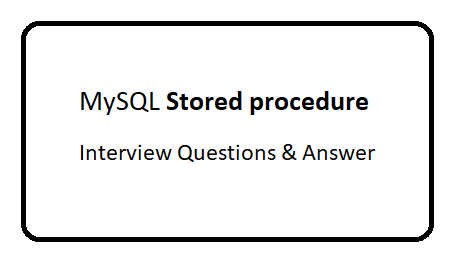
Question: What is stored procedure?
A stored procedure is Structured Query Language (SQL) statements which has a name, a parameter list, and SQL statement(s) stored in MySQL Server.
Question: Give example of stored procedure?
Question: Give example of stored procedure with parameter details?
Question: To show all stored procedures:
Question: How to show stored procedures in a specific database
Question: MySQL stored procedures advantages?
Question: MySQL stored procedures dis-advantages?
Question: How to call stored procedure with OR without arguments?
Call without argument
Question: How to delete the procedure?
Question: What if i am trying to delete the stored procedure for non-exist.?
It will give warning only, if you have used "IF EXISTS"
It will give Error, if you have used not used "IF EXISTS"
Question: How to Alter a stored procedure in mysql?
1: Delete the Stored procedure.
A stored procedure is Structured Query Language (SQL) statements which has a name, a parameter list, and SQL statement(s) stored in MySQL Server.
Question: Give example of stored procedure?
DELIMITER $$ CREATE PROCEDURE getUsersAscending() BEGIN SELECT first_name, last_name, email FROM users ORDER BY first_name; END$$ DELIMITER ;
Question: Give example of stored procedure with parameter details?
DELIMITER $$
CREATE PROCEDURE `getUsersDetails`(IdSearch INT)
BEGIN
SELECT
first_name,
last_name,
email
FROM
users
WHERE id=IdSearch;
END$$
DELIMITER ;Question: To show all stored procedures:
SHOW PROCEDURE STATUS;
Question: How to show stored procedures in a specific database
SHOW PROCEDURE STATUS WHERE Db = 'db_name';
Question: MySQL stored procedures advantages?
- Reduce network traffic
- Make database more secure
Question: MySQL stored procedures dis-advantages?
- Resource usages: If you use many stored procedures, the memory usage of every connection will increase substantially.
- Troubleshooting:MySQL does not provide any facilities to debug stored procedures like other enterprise database products such as Oracle and SQL Server
- Maintenances Developing and maintaining stored procedures often requires a specialized skill set that not all application developers possess.
Question: How to call stored procedure with OR without arguments?
Call without argument
call getUsersAscending();Call With argument
call getUsersDetails(10);
Question: How to delete the procedure?
DROP PROCEDURE IF EXISTS getUsersAscending;
Question: What if i am trying to delete the stored procedure for non-exist.?
It will give warning only, if you have used "IF EXISTS"
It will give Error, if you have used not used "IF EXISTS"
Question: How to Alter a stored procedure in mysql?
1: Delete the Stored procedure.
2: Re-Create the Stored procedure.